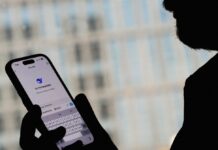But the news immediately spooked investors. Futures tied to the Dow Jones industrial average “indicated an opening loss of more than 400 points, recovering a bit after earlier trading down more than 500 points. S&P 500 futures and Nasdaq 100 futures were also in negative territory,” CNBC’s Eustance Huang and Pippa Stevens report.
The development throws a major unknown into the election at a time when uncertainty over voting and its outcome already has been weighing on investor sentiment. “Market sentiment was already delicately balanced ahead of the November election, and today’s news only adds to the uncertainty,” Karen Ward, chief market strategist for EMEA at J.P. Morgan Asset Management, told Bloomberg’s Yakob Peterseil. But, she said, “with such a wide range of outcomes and implications stemming from the President’s diagnosis, it’s too soon to ascertain what the final market direction will be.”
The market’s record suggests investors quickly absorb and move past history-bending shocks.
As we wrote here in January, when the market shrugged off threats of a briefly threatened conflict with Iran, “Twenty days after President John F. Kennedy’s assassination, for example, the S&P 500 was up 6.3 percent,” according to data from Strategas technical analyst Todd Sohn. “It was up 9.7 percent after the same interval following the 1987 stock market crash; 5.3 percent after the bombing of the USS Cole; 4.9 percent after the Sept. 11, 2001, terrorist attacks; and 6.4 percent after the Brexit referendum.”
Here’s another look at how quickly the market rallied back from some defining disruptions of the last 80 years, via of LPL Financial:
In this case, in the immediate term at least, the development could prove more vexing, since it injects a host of unknowns not only into the election but the country’s governance as well. Per the Post team, “The diagnosis is a jolt for the country’s leadership and had some advisers early Friday discussing the continuity of government should the president’s condition grow worse. The vice president was not known to be infected.”
Given the number of people the Trumps and Hicks have been in contact with in recent days, expect widespread testing in the days ahead on other top White House officials, congressional leaders, and Democratic presidential nominee Joe Biden and his team. “Since late Tuesday, Trump has appeared with thousands at a rally in Minnesota, debated Biden onstage and has interacted with a coterie of aides and political advisers at the White House,” the Post team writes. “There was no immediate answer from Biden’s camp as to whether he had been tested.”
Jobs report day
Investors will also be sorting through the September jobs report due out later this morning, the last before Election Day. It is expected to show the labor market recovery hitting a skid at the worst possible moment for Trump.
Economists project between 800,000 and 850,000 workers joined payrolls last month, a major drop-off from August, when the economy added about 1.4 million jobs. And the unemployment rate is expected to tick down from 8.4 percent to 8.2 percent. The average peak unemployment rate of the last seven recessions was 8.1 percent, according to Gregory Daco of Oxford Economics.
Economists’ consensus sees the unemployment rate ticking down from 8.4 percent to 8.2 percent. No incumbent president since World War II has faced a jobless rate higher than 7.7 percent and won — and none in that period has faced reelection after the economy posted a net loss of jobs over his term, which Trump is on track to do.
Economists say that traditional measure of unemployment dramatically understates the reality of the ongoing labor market damage wrought by the economic crisis. A more comprehensive assessment, factoring in those who are underemployed or have given up looking for work altogether, would indicate a rate as high as 18 percent, says RSM chief economist Joseph Brusuelas.
“The economy is only operating at around 80 percent of its capacity to produce and consume. That’s the underlying reality of the American condition roughly 30 days before the election, and that’s how people will look at the economy” as they determine their votes, he says.
A Thursday report from the Labor Department underscored how dire the situation remains for millions.
It found 837,000 initial unemployment claims were processed last week. “That figure has come down steadily from its peak in late March and April, but it is still higher than any other period before the coronavirus pandemic,” Eli Rosenberg writes. In fact, the ranks of those claiming some sort of unemployment benefits actually inched up to 26.5 million.
Meanwhile, personal income dropped 2.7 percent in August, a new report from the Commerce Department found, a sign that the recovery is facing new pressures as relief programs meant to pad American pocketbooks expire. Negotiations led by House Speaker Nancy Pelosi (D-Calif.) and Treasury Secretary Steven Mnuchin to extend those programs are continuing, though the two sides failed to reach a breakthrough Thursday.
The headwinds are weighing on businesses big and small alike, with a number of top corporations grabbing headlines this week by announcing major layoffs. The tally of those fired or furloughed comes to more than 60,000 and counting, according to the New York Times. From Eli’s story:
Economists will be looking beneath the headline unemployment number for more clues about the state of the jobs market. “The number of workers who have permanently lost their jobs has been rising, compared with those on temporary layoff or furlough,” Bloomberg’s Katia Dmitrieva and Jarrell Dillard write. “In addition, prior months have shown increases in Americans who have seen extended spells of unemployment.”
Ryan Sweet, director of real-time economics for Moody’s Analytics, tells me he’ll be focused on “the breadth of job growth and the number of temporary versus permanent layoffs.” But in terms of the presidential contest, he says, “the unemployment number is a very powerful predictor.”
Market movers
Dow ekes out small gains.
Lingering uncertainty over the stimulus loomed over markets: “The Dow Jones Industrial Average rose 35.20 points, or 0.1 percent, to 27,816.90 after jumping 250 points earlier in the day. The S&P 500 rose 0.5 percent, or 17.80 points, to 3,380.80, while the Nasdaq Composite outperformed, gaining 1.4 percent, or 159.00 points, to 11,326.51,” CNBC’s Yun Li, Maggie Fitzgerald and Eustance Huang report.
“Major technology shares, which could do well even without another stimulus, provided the broader market with some support as Amazon, Microsoft, Alphabet and Facebook all jumped at least 1 percent. Netflix popped 5.5 percent.”
Coronavirus fallout
More from the United States:
- At least 7,245,000 cases have been reported; at least 207,000 have died.
- Moderna chief says vaccine won’t be available until late March. “If Moderna’s coronavirus vaccine is proven safe and effective, the general population could have access to it by late March or early April next year, Moderna CEO Stéphane Bancel said on Wednesday,” per CNN.
- College towns continue remain weary as students remain on campus: “Campus outbreaks have fueled tensions in college towns and cities across the country, from San Diego to Morgantown, W.Va., even though there is little evidence so far of spillover into local populations,” Karin Brulliard reports. “In some communities, local governments and schools have presented a united front, but increases in cases have stirred resentment among residents and triggered student-directed crackdowns by public health officials.”
From the corporate front:
- PepsiCo sales snap back: “Revenue for PepsiCo’s North American beverage division climbed 6 percent to $5.96 billion, bouncing back from a decline of 7 percent in the previous quarter. Sales in restaurants and offices remain down by a lot, but revenue grew in convenience stores and gas stations, the company’s CFO Hugh Johnston said,” the Wall Street Journal’s Jennifer Maloney reports.
- Goldman’s job cuts mean total bank employment cuts near 70,000: “The Wall Street firm is embarking on a plan to eliminate about 1 percent of its workforce, or roughly 400 positions … Adding that to disclosures this week by other banks would take the total announced this year to 67,844, according to figures compiled by Bloomberg,” Nicholas Comfort reports.
- Pfizer CEO says presidential debate was “disappointing”: “Once more, I was disappointed that the prevention for a deadly disease was discussed in political terms rather than scientific facts,” Albert Bourla wrote in a memo to employees, CNBC’s Christina Farr reports.
- Bed Bath & Beyond’s sales surged: The company “said its digital sales surged 89 percent in the three months ended Aug. 31 … boosted in part by back-to-school sales, led the housewares chain to post its first rise in year-over-year comparable sales since 2016.Shares of the Union, N.J.-based retailer jumped 30 percent to $19.53 Thursday,” the Journal’s Matt Grossman reports.
Pocket change
Boeing to move 787 production to South Carolina next year.
The cost-cutting strategy raises questions about the company’s plant in Washington state: “Reuters first reported on Sept. 21 that Boeing was near a decision to move Dreamliner production to South Carolina as its strategy of supporting two plants has been severely tested by the coronavirus slump in international travel, on top of a cyclical downturn in demand for big jets,” Eric M. Johnson reports.
“As recently as last year, Boeing was making record numbers of 787s at its Everett widebody hub north of Seattle and — since 2012 — a second plant in North Charleston, South Carolina.”
Quibi’s slow start puts pressure on Jeffrey Katzenberg: “Quibi, one of Hollywood’s most ballyhooed startups, is having a rocky first year,” Bloomberg News’s Kelly Gilblom and Dave Merrill report.
“By compiling Quibi’s reported and public statements about content spending, advertising, subscribers and more, a picture emerges of a company headed for financial distress after a tough first year. In one scenario, if little changes, the company faces a funding shortfall of about $1.8 billion by 2024 and $6 billion by 2030. Katzenberg, who has made a career selling stories of characters beating the odds, has said he’s up for the test.”
Goldman Sachs buys GM’s credit card for roughly $2.5 billion: “Sachs, a newcomer to the credit-card space, won the bidding over Barclays … handing the Wall Street firm more than a million GM cardholders and their roughly $8.5 billion in annual spending,” the Journal’s AnnaMaria Andriotis and Liz Hoffman report.
“It is the second win in the credit-card sector for Goldman, which launched its first credit card last year with Apple Inc. and is on the hunt for other deals in co-branded cards. But it is barging in at a precarious moment: Banks deferred payments for millions of cardholders facing financial hardship from the pandemic and have set aside billions of dollars to cover potential losses if the debt doesn’t get paid back.”
Campaign 2020
Amazon and other tech companies are cozying up to Biden.
Contributions and connections continue to be key: “Amazon appears to have taken an early lead making in-roads with Joe Biden’s camp, according to data gathered by Reuters from OpenSecrets and campaign finance records, along with interviews with over a dozen stakeholders including anti-monopoly groups, lobbyists, congressional aides, competitors and lawmakers,” Reuters’s Nandita Bose reports.
“Joining Amazon, Alphabet’s Google and Microsoft are among the top five contributors to Biden’s candidate campaign committee in the 2020 cycle, according to data from OpenSecrets, a website which tracks money in politics and campaign finance records. The firms are prohibited by law from donating themselves. The contributions were either made by the company’s political action committees (PACs) themselves, members of the PAC or their employees.”
Trade and covid could cost Republicans a U.S Senate seat in Iowa: “Sen. Joni Ernst (R-Iowa) is running behind in her quest for reelection on Nov. 3, after binding herself both to the president and Senate Majority Leader Mitch McConnell’s leadership team in her first term. A member of the Judiciary Committee, she’s looking to the fight with Democrats over Trump’s pick to replace the late Supreme Court Justice Ruth Bader Ginsburg to energize Iowa Republicans,” Bloomberg News’s Laura Litvan reports.
“Polls show Theresa Greenfield, a 56-year-old real estate executive contesting a statewide office for the first time, with a slight lead. A win over Ernst, 50, would give Democrats one of the three or four seats they need for their first Senate majority in six years, depending on whether Joe Biden beats Trump.”
Daybook
- The Labor Department releases the monthly jobs report, the last before Election Day.








